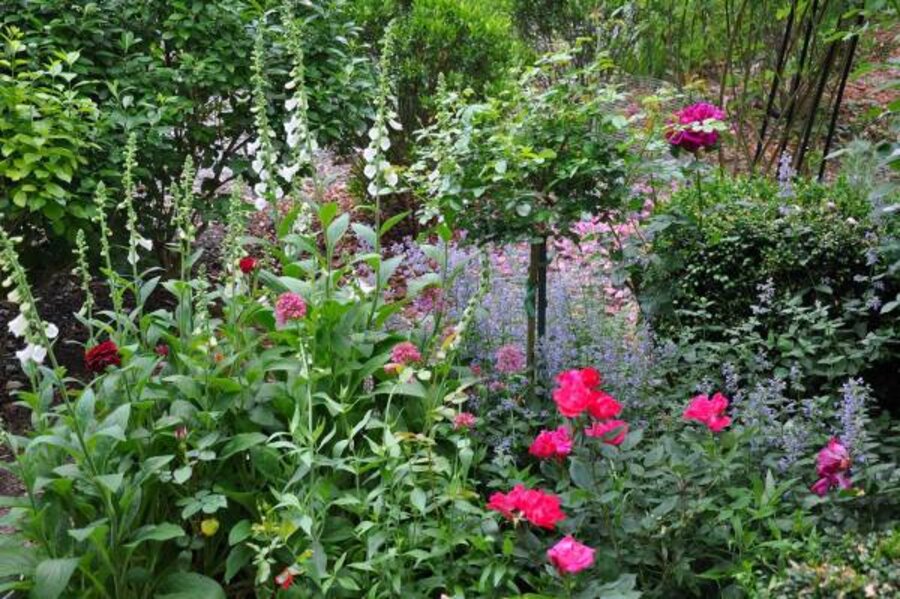Spring cleaning in the rose garden
Loading...
Staring at enticing photos of roses in magazines, books, and catalogs during winter makes it easy to conjure up images of warm days, fragrant blooms, and lush green foliage. But one look outside quickly snaps you back to reality: The garden’s a mess.
Dead leaves -- some reflecting the effects from a final battle with blackspot and mildew -- are everywhere. Untidy bushes desperately need a haircut. And many plants are showing signs of damage from this year’s severe weather.
So what kind of miracle will it take to bring this garden back to picture-perfect status? The answer is a little TLC and a lot of elbow grease.
In most areas of the country, a good rule of thumb is to start your garden clean-up when the forsythia blooms. Start by pulling off any diseased leaves that have wintered over on your rose bushes. Dispose of them right away – don’t throw them on the ground or you’ll be inviting even more disease problems.
Then get out your newly sharpened pruning shears and remove dead wood right down to the bud union. To help improve air circulation, remove any canes that crisscross, canes that grow into the center of the bush and any weak, spindly growth.
Diseased or winter-damaged canes should be pruned to the point where you find light green or white pith. Make your cuts at a 45-degree angle about 1/4 inch above a leaf bud that faces toward the outside of the plant.
How severely you prune depends on the type of rose. Unless you plan to exhibit, most experts recommend moderate pruning of 18 to 24 inches for hybrid teas, floribundas, and grandifloras.
Hybrid perpetual roses, shrub roses, and old garden roses generally only require thinning and shaping, so limit yourself to removing only old canes, dead wood, and spindly growth.
David Austin English roses in particular do not like severe haircuts.
Pruning climbing roses can be a bit trickier. Climbers that have only one flowering period should be pruned after they bloom. Take out old, weak, or entangled branches.
Repeat-blooming climbers need to be pruned while dormant in the spring. Again, remove any old or unproductive canes, then cut back side shoots to pencil thickness.
Miniature roses and minifloras are your easiest task. A recent study showed meticulous pruning didn’t really affect the plant’s success at all. So whether you use secateurs or a chain saw, cut back minis to about half of last summer’s height.
After pruning, paint any cuts wider than a straw with a sealing compound (Elmer’s glue will do fine) to discourage insects and disease.
Once your pruning is complete, rake up and bag the cuttings, leaves, and old mulch that remain on the ground or around the base of your bushes. This debris can be a source of insect eggs and disease spores.
After tidying up the rose beds, you’ll want to give those hungry bushes their first meal of the year. Roses are very greedy feeders and perform best when offered a healthy diet.
To make sure your roses get the 16 nutrients they need, it’s a good idea to have your soil tested. The results can help you pinpoint problems and add the necessary amendments.
There are many opinions on which fertilizing program is best, but in my garden I spread well-rotted horse manure and a basic 10-10-10 fertilizer right after pruning. Then, every other week during the growing season, I spray the leaves with a liquid fertilizer.
As a final step, sprinkle 1/4 cup of Epsom salts around each bush and “rough up” the bud unions with a wire brush to encourage basal breaks.
Then put your feet up and start counting the days until your roses look as healthy and glorious as those in any magazine.
PSSSST: Give your roses an extra treat by spreading some alfalfa pellets around each bush. They will thank you for it later.
Lynn Hunt, the Rose Whisperer, is one of nine garden writers who blog regularly at Diggin' It. She's an accredited horticultural judge and a Consulting Rosarian Emeritus for the American Rose Society. She has won dozens of awards for her writing in newspapers, magazines, and television. She grows roses and other plants in her garden on the Eastern Shore of Maryland.
-----
Follow us on Twitter and Facebook.
To read more by Lynn, click here. The Monitor’s main gardening page offers articles on many gardening topics. Access all our blog posts here. (These URLs have recently changed, so you may want to bookmark them so you can return easily.) See also our RSS feed. You may want to visit Gardening With the Monitor on Flickr. Take part in the discussions and get answers to your gardening questions. If you join the group (it’s free), you can upload your garden photos and enter our next contest.





